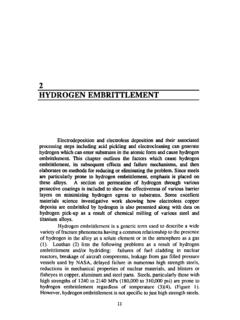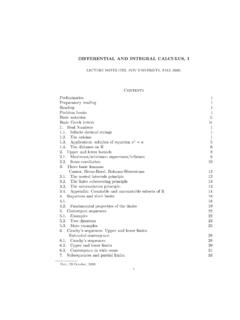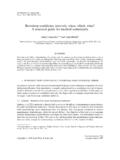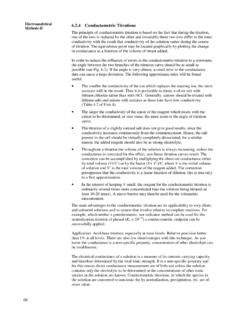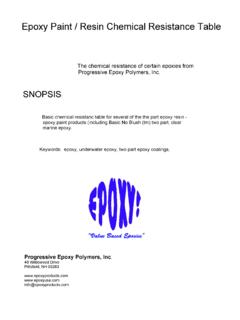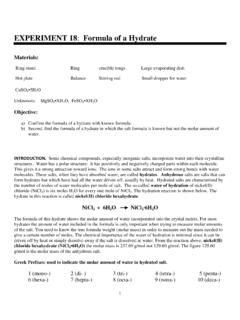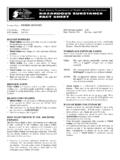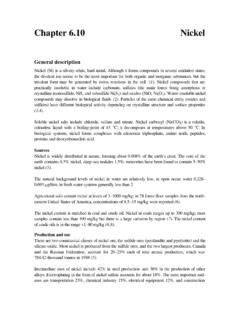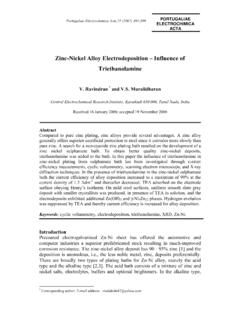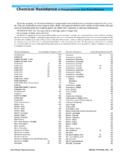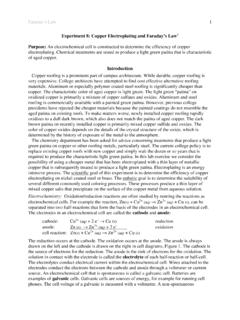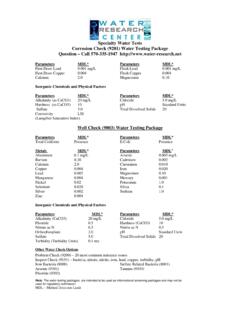Transcription of Chapter The Fundamental Aspects Of Electroless Nickel Plating
1 Chapter 1 The Fundamental Aspects Of Electroless Nickel Plating Glenn 0. Mallory The chemical deposition of a metal from an aqueous solution of a salt of said metal has an electrochemical mechanism, both oxidation and reduction (redox), reactions involving the transfer of electrons between reacting chemical species. The oxidation of a substance is characterized by the loss of electrons, while reduction is distinguished by a gain of electrons. Further, oxidation describes an anodic process, whereas reduction indicates a cathodic action. The simplest form of chemical Plating is the so-called metal displacement reaction. For example, when zinc metal is immersed in a copper sulfate solution, the zinc metal atoms (less noble) dissolve and are spontaneously replaced by copper atoms from the solution. The two reactions can be represented as follows: Oxidation: Zno - Zn + 2e-, anodic, Eo = V Reduction: Cu + 2e- - Cuo, cathodic, Eo = V Owera// reaction: ZnO + Cu - Zn + Cuo, Eo = V As soon as the displacement reaction begins, the surface of the zinc substrate becomes a mosaic of anodic (zinc) and cathodic (copper) sites.
2 The displacement process continues until almost the entire substrate iscovered with copper. At this point, oxidation (dissolution) of thezincanodevirtually stops and copper deposition ceases. Chemical Plating by displacement yields deposits limited to only a few microns in thickness, usually 1 to 3 pm. Hence, chemical Plating via the displacement process has few applications. In order to continuously build thick deposits by chemical means without consuming the substrate, it is essential that a sustainable oxidation reaction be employed as an alternative to the dissolution of the substrate. The deposition reaction must occur initially and exclusively on the substrate and subsequently continue to deposit on the initial deposit. The redox potential for this chemical process is usually more positive than that for a metal being deposited by immersion. The chemical deposition of Nickel metal by hypophosphite meets both the oxidation and redox potential criteria without changing the mass of the substrate: 1 2 Electroless Plating Reduction: Nit' + 2e- - Ni" E" = -25 mV Oxidation: H2PO; + H?
3 O - HpO; + 2H' + 2e- E" = +50 mV Ni'* + H2PO; + H?O - Ni" + H2PO; + 2H' E" = +25 mV which is the sum of the oxidation and reduction equations. This reaction does not represent the true Electroless Plating reaction, since EN deposition is accompanied by hydrogen evolution. Figure shows the difference between immersion and Electroless deposition by comparing deposit thickness vs. time. The term electrolessplating was originally adopted by Brenner and Riddell (1) to describe a method of Plating metallic substrates with Nickel or cobalt alloys without the benefit of an external source of electric current. Over the years, the term has been subsequently broadened to encompass any process that continuously deposits metal from an aqueous medium. In general, Electroless Plating is characterized by the selective reduction of metal ions only at the surface of a catalytic substrate immersed into an aqueous solution of said metal ions, with continued deposition on the substrate through the catalytic action of the deposit itself.
4 Since the deposit catalyzes the reduction reaction, the term autocatalytic is also used to describe the Plating process. Fig. vs. time-comparison between Electroless and immersion deposition. The Fundamental Aspects of Electroless Nickel Plating 3 In 1844, Wurtz (2) observed that Nickel cations were reduced by hypo- phosphite anions. However, Wurtz only obtained a black powder. The first bright metallic deposits of Nickel -phosphorus alloys were obtained in 191 1 by Breteau (3). In 1916, Roux (4) was issued the first patent on an Electroless Nickel Plating bath. However, these baths decomposed spontaneously and formed deposits on any surface that was in contact with thesolution, even the wallsofthecontainer. Other investigators studied the process, but their interest was in the chemical reaction and not the Plating process. In 1946, Brenner and Riddell (1) published a paper that described the proper conditions for obtaining Electroless deposition as defined above.
5 Over the years, the process has been investigated further and expanded by many workers to its present state of development. THE Electroless Nickel Plating BATH: COMPONENTS Electroless Nickel (EN) Plating is undoubtedly the most important catalytic Plating process in use today. The principal reasons for its widespread commercial and industrial use are to be found in the unique properties of the EN deposits. The chemical and physical properties of an EN coating depend on its composition, which, in turn, depends on the formulation and operating conditions of the EN Plating bath. Typically, the constituents of an EN solution are: A source of Nickel ions A reducing agent Suitable complexing agents Stabilizers/inhibitors Energy The Nickel Source The preferred source of Nickel cations is Nickel sulfate. Other Nickel salts, such as Nickel chloride and Nickel acetate, are used for very limited applications. The chloride anion can act deleteriously when the EN Plating bath is used to plate aluminum, or when the EN deposit is used as a protective coating over ferrous alloys in corrosion applications.
6 The use of Nickel acetate does not yield any significant improvement in bath performance or deposit quality when compared to Nickel sulfate. Any minor advantages gained by Nickel acetate are offset by its higher cost vs. the cost of Nickel sulfate. The ideal source of Nickel ions is the Nickel salt of hypophosphorus acid, Ni(H2P02)?. The use of Nickel hypophosphite would eliminate the addition of sulfate anions and keep to a minimum the buildup of alkali metal ions while replenishing the reactants consumed during metal deposition. The concentration of Nickel ions and its relationship to the reducing agent and complexing agent concentrations will be discussed in a succeeding Chapter . 4 Electroless Plating Reduclng Agents Four reducing agentsare used in thechemical reduction of Nickel from aqueous solutions: Sodium hypophosphite NaH2P02. HzO Sodium borohydride L J Dimethylamine borane (DMAB) CHI H CH/A 'H 'N--~H Hydrazine N2H4 H20 The four reducing agents are structurally similar in that each contains two or more reactive hydrogens, and Nickel reduction is said to result from the catalytic dehydrogenation of the reducing agent.
7 Table gives a summary of Nickel reducing agents. Electroless Nickel deposition can be viewed, in a very elementary manner, as the sum of two chemical reactions occurring in an electrochemical cell-a chemical oxidation reaction that liberates electrons and a Nickel reduction reaction that consumes electrons: Oxidation of reducing agent Red - Ox + ne Reduction of Nickel ion mNi" + 2me- - mNio, 2m = n The Fundamental Aspects of Electroless Nickel Plating 5 Overall or sum reaction mNi" + Red - mNi" + Ox The sum equation is a schematic illustration of the type of stoichiometric reactions usually written to describe the chemical reduction of Nickel by a reducing agent. However, these overall reactions do not account for all of the phenomena that are observed during Plating . Experimentally observed reaction characteristics indicate that the course of the reaction is considerably more complex than described by simple stoichiometric equatims.
8 Hence, it is necessary to attempt to ascertain the mechanism of the Nickel reduction by the various reducing species. Reducing agent Sodium hypophosphite Sodium borohydride Dimethylamine borane Hydrazine NaH,PO:,H:O NaBH, (CH,):NHBH, H:NNH: Table Nickel Reducing Agents Mol. Equiv. PH E", wt. wt. range volts 4-6 106 53 7-1 0 38 12-14 59 6-10 - 32 8-1 1 An explicit understanding of the reaction mechanisms that govern Electroless Nickel deposition is necessary from both theoretical and practical viewpoints. Knowledge of the mechanisms of the reaction of a reducing agent with Nickel ions can lead to the solution of a series of problems-development of methods to increase the Plating rate, for enhancing hypophosphite efficiency, and for regulating the phosphorus or boron content of the deposit. It must be emphasized that an understanding of the course of the reaction, especially as it relates to the reduction of phosphorus or boron, is extremely important.
9 It is the inclusion of P or B in the respective Nickel alloys (Ni-P and Ni-B) that determines the properties of each alloy. Before discussing the individual reducing agents and the proposed mechanisms of their reactions with Nickel , it might be informative to recall certain characteristics of the process that the mechanism must explain: 6 Electroless Plating *The reduction of Nickel is always accompanied by the evolution of hydrogen The deposit is not pure Nickel but contains either phosphorus, boron or The reduction reaction takes place only on the surface of certain metals, but Hydrogen ions are generated as a by-product of the reduction reaction. The utilization of the reducing agent for depositing metal is considerably The molar ratio of Nickel deposited to reducing agent consumed is usually gas. nitrogen, depending on the reducing medium used. must also take place on the depositing metal. less than 100 percent. equal to or less than 1.
10 Hypophosphite Nickel deposition by hypophosphite was sometimes represented in the literature by the following equations: Ni" + H2PO; + H20 - Nio + H2PO; + 2H' [I1 H2PO; + HIO cat, H:PO; + HI [21 overall Ni" + 2 HjPOi + 2H20 - NiU + 2H:PO; + 2H' + H: 131 The reduction of Nickel ions with hypophosphite yields alloys of Nickel and phosphorus; however, Eqs. 1, 2, and 3 completely fail to account for the phosphorus component of the alloy. Further, if the Plating reaction took place in accordance with the above equations, the rate of deposition would be proportional to the concentrations of the reactants. Gutzeit (5) hasshown that in acid Plating solutions (pH > ), the Plating rate has a first order dependence upon the hypophosphite concentration. That is, Plating rate is dependent on the hypophosphite concentration, over a very wide concentration range. Gutzeit further showed the rate to be independent of the Nickel ion concentration beyond about Ni"; the rate is said to have a zero order dependence on Nickel concentration.]]



